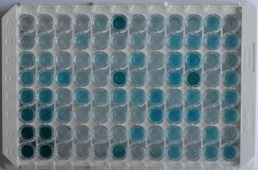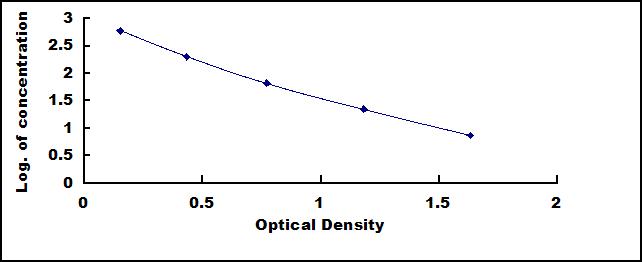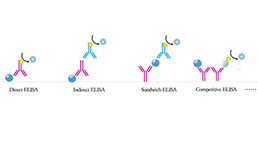Packages (Simulation)

Reagent Preparation

Image (I)
Image (II)
Certificate


ELISA Kit for Apelin 36 (AP36)
APLN36
- Product No.CEB865Ra
- Organism SpeciesRattus norvegicus (Rat) Same name, Different species.
- Sample Typeserum, plasma and other biological fluids
- Test MethodCompetitive Inhibition
- Assay Length2h
- Detection Range7.41-600pg/mL
- SensitivityThe minimum detectable dose of this kit is typically less than 2.84pg/mL.
- DownloadInstruction Manual
- UOM 48T96T 96T*5 96T*10 96T*100
- FOB
US$ 505
US$ 722
US$ 3249
US$ 6137
US$ 50540
For more details, please contact local distributors!
Specificity
This assay has high sensitivity and excellent specificity for detection of Apelin 36 (AP36).
No significant cross-reactivity or interference between Apelin 36 (AP36) and analogues was observed.
Recovery
Matrices listed below were spiked with certain level of recombinant Apelin 36 (AP36) and the recovery rates were calculated by comparing the measured value to the expected amount of Apelin 36 (AP36) in samples.
| Matrix | Recovery range (%) | Average(%) |
| serum(n=5) | 87-101 | 90 |
| EDTA plasma(n=5) | 78-102 | 89 |
| heparin plasma(n=5) | 78-93 | 85 |
Precision
Intra-assay Precision (Precision within an assay): 3 samples with low, middle and high level Apelin 36 (AP36) were tested 20 times on one plate, respectively.
Inter-assay Precision (Precision between assays): 3 samples with low, middle and high level Apelin 36 (AP36) were tested on 3 different plates, 8 replicates in each plate.
CV(%) = SD/meanX100
Intra-Assay: CV<10%
Inter-Assay: CV<12%
Linearity
The linearity of the kit was assayed by testing samples spiked with appropriate concentration of Apelin 36 (AP36) and their serial dilutions. The results were demonstrated by the percentage of calculated concentration to the expected.
| Sample | 1:2 | 1:4 | 1:8 | 1:16 |
| serum(n=5) | 94-101% | 91-105% | 98-105% | 81-92% |
| EDTA plasma(n=5) | 78-91% | 96-103% | 86-93% | 87-105% |
| heparin plasma(n=5) | 91-98% | 92-105% | 82-96% | 92-101% |
Stability
The stability of kit is determined by the loss rate of activity. The loss rate of this kit is less than 5% within the expiration date under appropriate storage condition.
To minimize extra influence on the performance, operation procedures and lab conditions, especially room temperature, air humidity, incubator temperature should be strictly controlled. It is also strongly suggested that the whole assay is performed by the same operator from the beginning to the end.
Reagents and materials provided
| Reagents | Quantity | Reagents | Quantity |
| Pre-coated, ready to use 96-well strip plate | 1 | Plate sealer for 96 wells | 4 |
| Standard | 2 | Standard Diluent | 1×20mL |
| Detection Reagent A | 1×120µL | Assay Diluent A | 1×12mL |
| Detection Reagent B | 1×120µL | Assay Diluent B | 1×12mL |
| TMB Substrate | 1×9mL | Stop Solution | 1×6mL |
| Wash Buffer (30 × concentrate) | 1×20mL | Instruction manual | 1 |
Assay procedure summary
1. Prepare all reagents, samples and standards;
2. Add 50µL standard or sample to each well.
And then add 50µL prepared Detection Reagent A immediately.
Shake and mix. Incubate 1 hour at 37°C;
3. Aspirate and wash 3 times;
4. Add 100µL prepared Detection Reagent B. Incubate 30 minutes at 37°C;
5. Aspirate and wash 5 times;
6. Add 90µL Substrate Solution. Incubate 10-20 minutes at 37°C;
7. Add 50µL Stop Solution. Read at 450 nm immediately.
GIVEAWAYS
INCREMENT SERVICES
| Magazine | Citations |
| European Journal of Obstetrics & Gynecology and Reproductive Biology | Apelin levels in relation with hormonal and metabolic profile in patients with polycystic ovary syndrome ScienceDirect: S0301211514000931 |
| Eur J Obstet Gynecol Reprod Biol. | Apelin?levels?in?relation?with?hormonal?and metabolic profile in patients with polycystic ovary syndrome. Pubmed:24642195 |
| J Obstet Gynaecol Res. | Apelin?levels are higher in obese patients with?endometrial?cancer. Pubmed:25160885 |
| Disease Markers | Apelin and Atrial Fibrillation: The Role in the Arrhythmia Recurrence Prognosis Pubmed:29721104 |
| Clinical and Experimental Hypertension | Serum concentrations of apelin-17 isoform vary in accordance to blood pressure categories in individuals with obesity class 3 Pubmed:29652188 |
| Acta Cardiologica Sinica | The Relationship between Serum Apelin Levels and the Severity of Calcific Aortic Stenosis Pubmed:29844647 |
| Disease Markers | Find the Essence through the Phenomena: Cardiovascular Diseases and Biomarkers Pubmed: 30034556 |
| Catalog No. | Related products for research use of Rattus norvegicus (Rat) Organism species | Applications (RESEARCH USE ONLY!) |
| CEB865Ra | ELISA Kit for Apelin 36 (AP36) | Enzyme-linked immunosorbent assay for Antigen Detection. |
| LMB865Ra | Multiplex Assay Kit for Apelin 36 (AP36) ,etc. by FLIA (Flow Luminescence Immunoassay) | FLIA Kit for Antigen Detection. |









